Sphinx
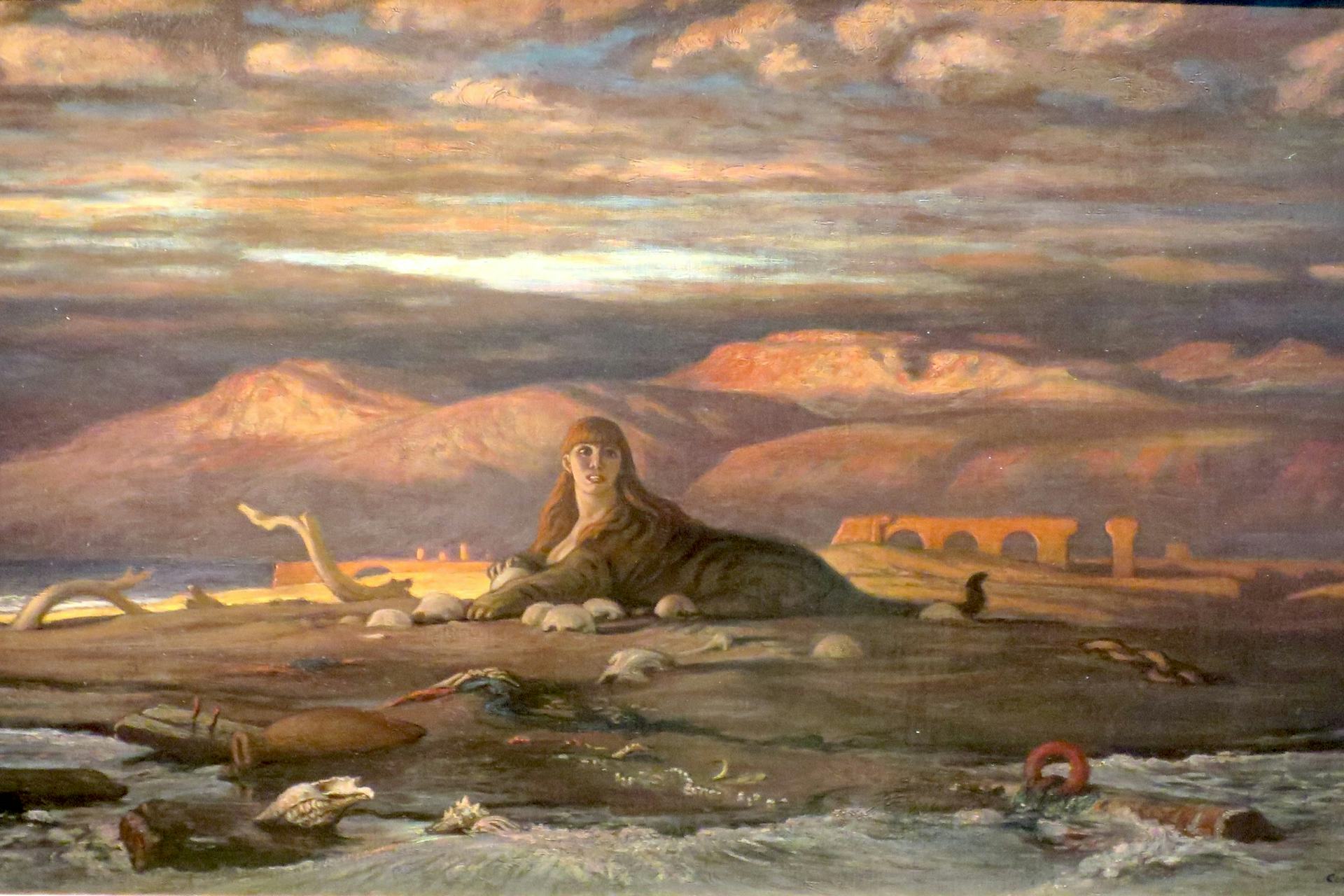
The Sphinx of the Seashore by Elihu Vedder (1879).
de Young MuseumPublic DomainOverview
The Sphinx was a hybrid creature of Greek, Egyptian, and Mesopotamian lore, usually represented as part human and part lion. Sometimes it also boasted avian anatomy, such as the wings of an eagle or falcon. In Greek mythology, the Sphinx was always female.
The Greek version of the Sphinx was usually called the offspring of either Orthus and the Chimera or of Typhoeus and Echidna (there were different versions). She made her lair outside the city of Thebes, where she confronted travelers and passers-by with a riddle and killed them when they failed to answer correctly. But when Oedipus finally solved her riddle, the Sphinx leapt to her death.
The Greeks also thought of the Sphinx as a kind of Underworld demon. Sphinxes were extremely popular in ancient art and continue to make frequent appearances in modern media.
Etymology
It seems that in ancient Greece, a popular or folk etymology derived the name “Sphinx” (Σφίγξ, translit. Sphínx) from the Greek verb σφίγγω (sphíngō, “to bind”).[1] But the true etymology is uncertain.[2]
Pronunciation
English
Greek
Sphinx, Sphinxes/Sphinges Σφίγξ, Σφίγγες (translit. Sphínx, Sphínges) Phonetic
IPA
[sfingks] /sfɪŋks/
Alternate Names
The name “Sphinx” varied somewhat according to local dialects. The most significant variation is the Boeotian Φίξ (Phíx), employed, for example, by the great Boeotian poet Hesiod in his Theogony.[3]
Attributes
Locale
The Greek Sphinx lived near Thebes, an important city in the central Greek region of Boeotia. Some sources provided an even more precise location for her lair: Mount Phicium, to the west of Thebes.[4] Others added that the Sphinx originally came from Ethiopia.[5]
Appearance and Abilities
The Sphinx was a hybrid creature, like the Chimera or griffin. Though versions of it were known in Egypt and Mesopotamia (see below), the Greek Sphinx was usually represented with the body of a lion and the head of a human woman. In many sources it also had wings, while later sources added that it had a snake for a tail.[6]
Armed with her famous riddle, which she was sometimes said to have learned from the Muses themselves, the Sphinx brought much suffering to the city of Thebes. She would sit in her lair outside the city, present her riddle to travelers and passers-by, and kill and devour those who failed to answer correctly.[7]
Iconography
Sphinxes were popular in Greek art from as early as the Bronze Age. Some of these early representations featured a man’s head, but by the fifth century BCE, the Sphinx—increasingly connected with the mythology of Thebes—was always female. In art as in literature, the Sphinx was usually shown with a lion’s body and a human head, sometimes wearing a headdress. It often had wings.
Sphinxes were frequently depicted in vase paintings and sculpture, often in mythological scenes with Oedipus. They were also used as decorative elements in architecture and furniture and even appeared on coinage and official paraphernalia, such as seals (the signet ring of the Roman emperor Augustus, for example, had a sphinx on it). Finally, since sphinxes were associated with the Underworld, they were often depicted on funerary objects, such as sarcophagi, urns, and grave altars.[8]
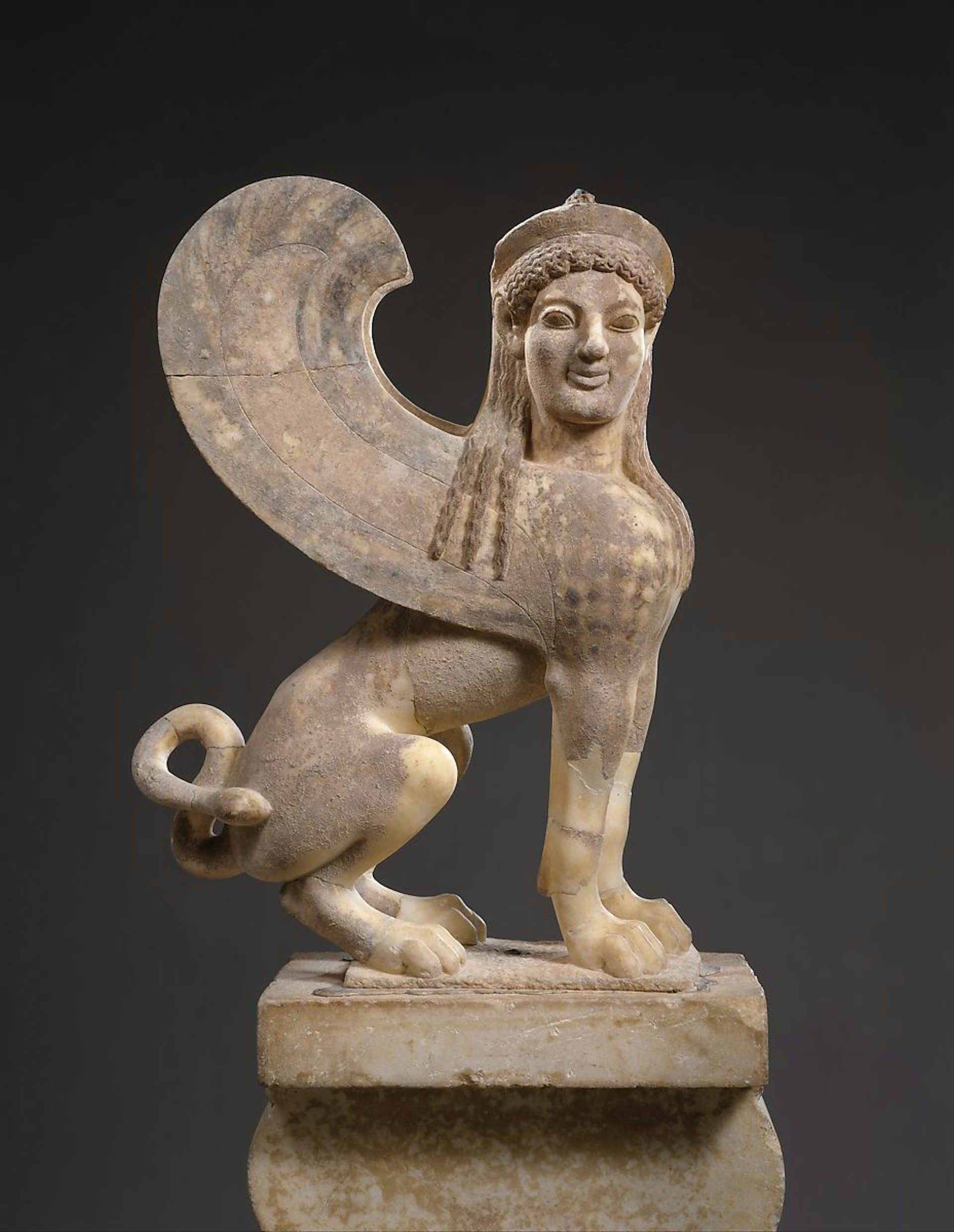
Marble capital and finial in the form of a Sphinx (ca. 530 BCE).
Metropolitan Museum of ArtPublic DomainFamily
Family Tree
Mythology
Origins
Sphinxes originated somewhere in the Near East. As early as the middle of the third millennium BCE, they were widespread in the art, heraldry, and religious images of Egypt and Mesoptomia. The Great Sphinx of Giza, for example, was likely erected during the reign of the pharaoh Khafre (ca. 2558–2532 BCE), whom it was said to represent. Both Egyptian and Mesopotamian sphinxes were often shown slaying or trampling humans, most likely the enemies of the king.
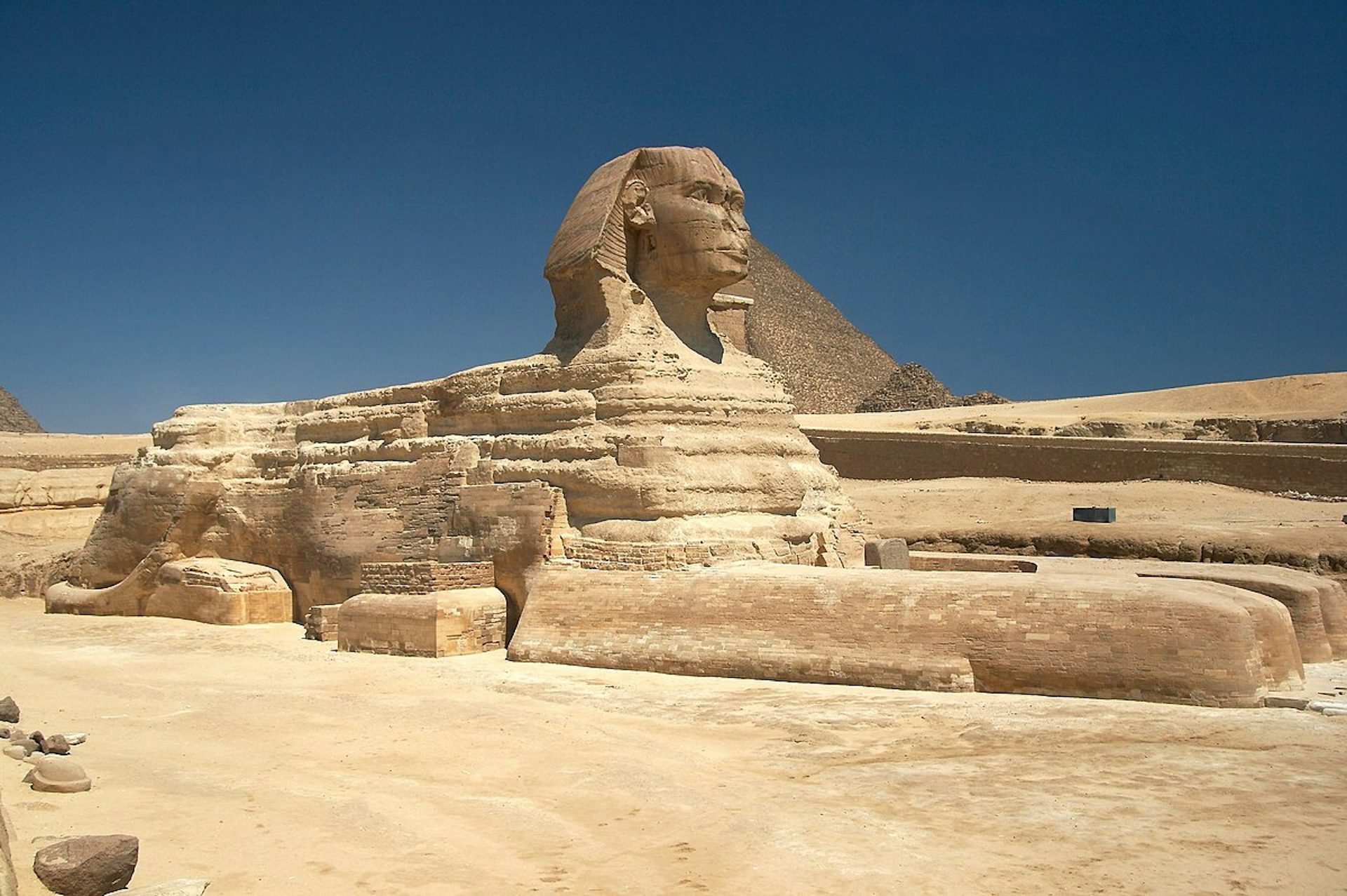
The Great Sphinx in Giza, Egypt.
BarcexCC BY-SA 3.0Typically, the Egyptian or Mesopotamian sphinx possessed the body of a lion and the head of a human. Sometimes it also had wings or horns.
Though the Greek Sphinx was female, Eastern sphinxes could be either sex. The Egyptian sphinx, for example, often represented the pharaoh or the male gods he embodied and thus had a male rather than a female head—what the Greeks sometimes called the “androsphinx” (ἀνδροσφίγξ, “man-sphinx”).[16] Egyptian sphinxes could also have the head and wings of a falcon (representing Horus) or of a ram (representing Amon). However, sphinxes with the head of a human female (like the Greek Sphinx) were not unknown in the East: they were rather popular in Syria and Anatolia, especially in Hittite architecture, and were even attested occasionally in Egypt.
The Sphinx arrived in Greece sometime during the Minoan period (ca. 2000–1450 BCE) or the Mycenaean period (ca. 1600–1100 BCE). Its primary inspiration was likely the Egyptian sphinx.[17] Throughout subsequent historical periods, the Sphinx continued to thrive in Greek art, culture, and, of course, mythology.
The Riddle of the Sphinx
In ancient Greece, the Sphinx was closely associated with Thebes, one of the most storied cities of Greek mythology. It was said that one of the gods sent her there to punish the Thebans for some offense (the identity of the god and the details of the offense vary depending on the source).[18]
According to the familiar version of the myth, the Sphinx made her lair in the mountains outside of Thebes and confronted everyone that crossed her path with a riddle. In its simplest prose form, the riddle ran like this:
What is that which has one voice and yet becomes four-footed and two-footed and three-footed?[19]
But the ancients sometimes also quoted the riddle in verse:
There walks on land a creature of two feet, of four feet, and of three; it has one voice, but, sole among the animals that grow on land or in the sky or beneath the sea, it can change its nature; nay, when it walks propped on most feet, then is the speed in its limbs less than it has ever been before.[20]
Whenever someone failed to answer the riddle correctly, the Sphinx would kill and devour them. Many noble Thebans died this way, including (according to some accounts) a son of Creon, one of the city’s most powerful figures.[21] In his desperation, Creon announced that anyone who successfully answered the riddle and rid Thebes of the Sphinx could marry Jocasta, the widow of the late king Laius, and become the new king of Thebes.
The Sphinx finally met her match in Oedipus, who was actually the son of Laius and Jocasta (though he himself did not know it at the time). When the Sphinx posed her riddle, Oedipus reasoned that humans walk on all fours as infants, on two legs as adults, and on three legs—their two legs and a cane—when old. He thus responded with the correct answer: man.
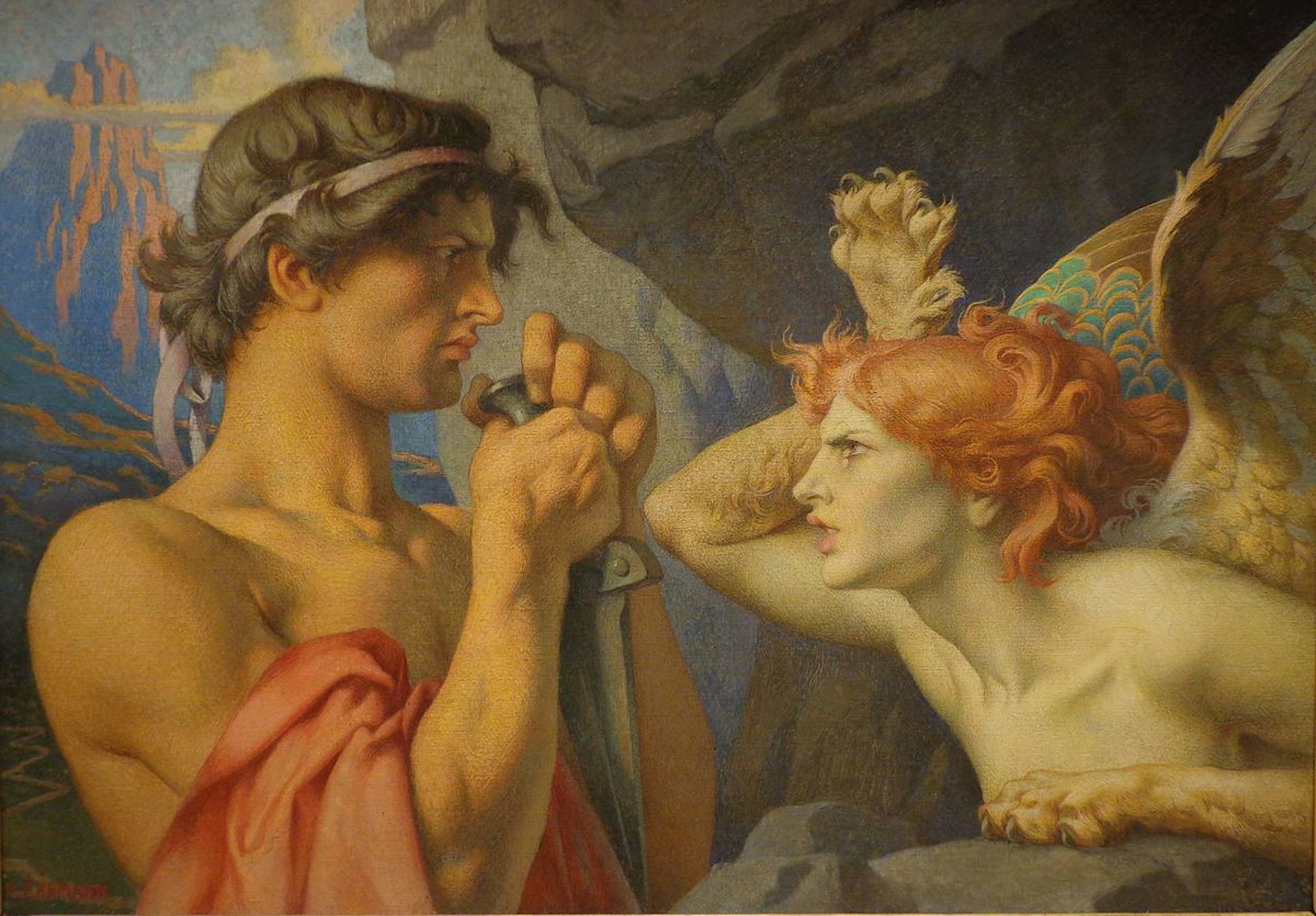
Oedipus and the Sphinx by François-Émile Ehrmann (1903). Strasbourg Museum of Modern and Contemporary Art, Strasbourg, France.
Wikimedia CommonsPublic DomainThe Sphinx then either hurled herself off a cliff to her death (the common version)[22] or was killed by Oedipus.[23] After this triumph, Oedipus became king of Thebes and married Jocasta, not knowing that she was his own mother.
Other Versions
There were several alternative accounts of the Sphinx’s mythology in antiquity. These are known to us today only in summary form from various scattered sources.
In one version, a kind of “rationalization” of the traditional myth, the Sphinx was not a monster at all but a female bandit. The leader of a small army of outlaws, this “Sphinx” devastated the Theban countryside until Oedipus either raised an army of his own and defeated her or murdered her using trickery.[24]
In another version, “Sphinx” was the name of one of King Laius’ many illegitimate children. Paranoid about the succession of his throne, Laius taught his daughter Sphinx an ancient prophecy, passed down from one king of Thebes to the next. It was said that only the true king—that is, the legitimate son of Laius and his queen—would know this prophecy. Thus, whenever Laius’ illegitimate sons came to Thebes seeking their father, Sphinx would ask them about the prophecy and kill them if they did not know it. When Laius’ long-lost son Oedipus came to Thebes, however, he was able to quote the prophecy correctly, having learned it in a dream.[25]
In another version, also a rationalization, the Sphinx was not a monster but rather a female seer who warned the Thebans of their imminent doom.[26]
Finally, there was one further version in which the Sphinx was originally one of the daughters of Cadmus, the founder and first king of Thebes. But she went mad, probably as a result of Cadmus’ descendants’ refusal to acknowledge the new god Dionysus, and was transformed into a monster—the famous Sphinx.[27]
Worship
The Sphinx was not worshipped as a divinity in ancient Greece, but sphinxes were popular in religious contexts. Many sculpted votives—that is, offerings left at temples, shrines, or altars of the gods—were modeled after the Sphinx. One famous example is the Sphinx of the Naxians, a sculpture of the Sphinx sitting atop an Ionic column, discovered near the Temple of Apollo at Delphi.
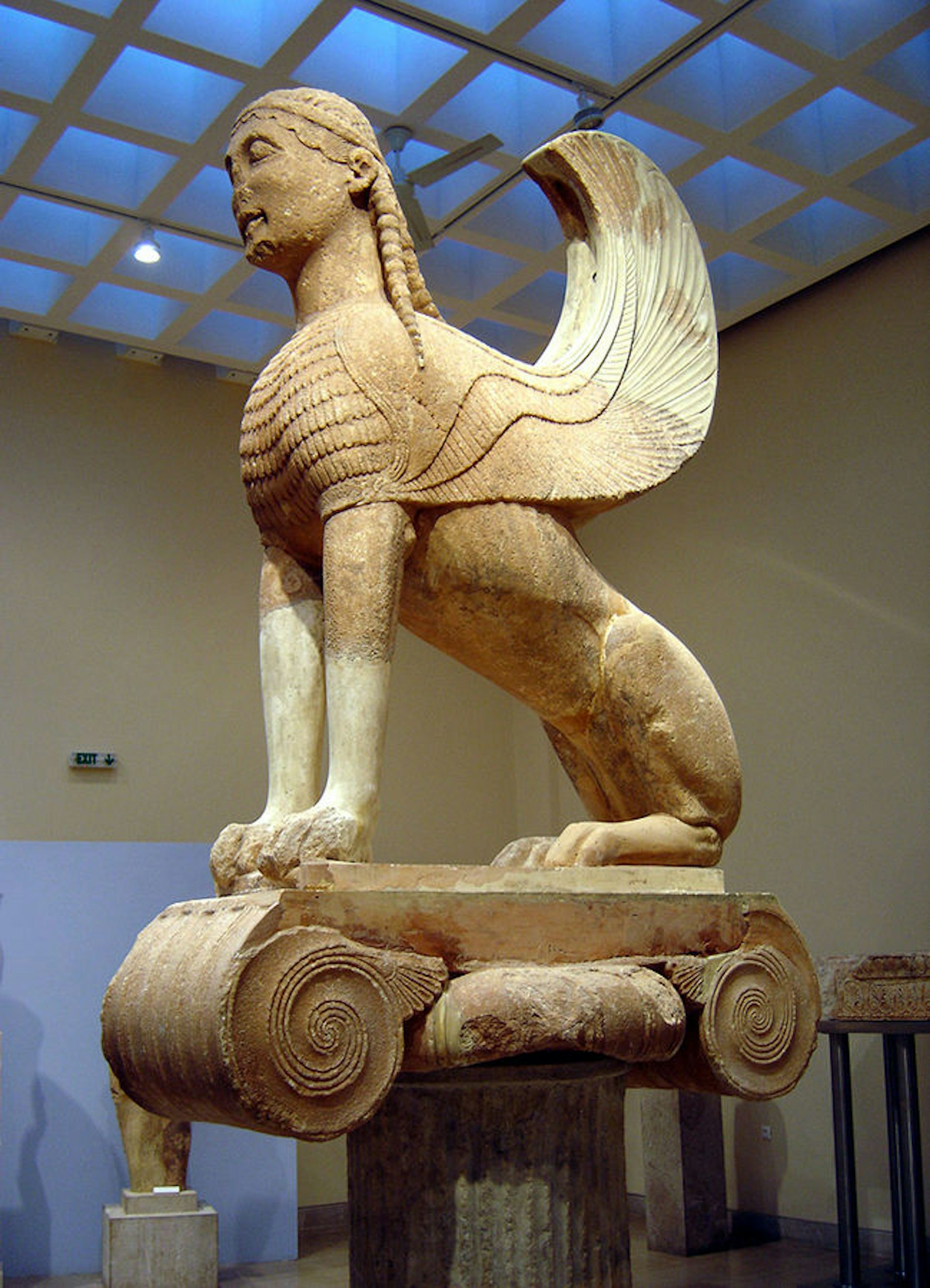
The Sphinx of Naxos, dedicated at Delphi ca. 560 BCE. Delphi Archaeological Museum, Delphi, Greece.
Ricardo Andre FrantzCC BY-SA 3.0The Sphinx was also associated with the Underworld from an early period. In popular religion, the creature appears to have been seen as a kind of Underworld demon or a guardian of the grave. As such, sphinxes were sometimes used as decoration on grave stelae in Attica.[29]
Pop Culture
Sphinxes have retained an important presence in modern popular culture. The Greek version of the Sphinx is most often remembered for her riddle, and today the phrase “riddle of the Sphinx” is often used to designate any difficult or unsolvable conundrum.
The Sphinx has often appeared in modern retellings of Greek myths. In Jean Cocteau’s play The Infernal Machine (1934), the Sphinx actually gives Oedipus the answer to her riddle so she can finally stop killing and end her own life. The Sphinx has also appeared in popular franchises inspired by Greek mythology, including Xena: Warrior Princess (The Huntress and the Sphinx is the title of a 1997 tie-in novel) and Rick Riordan’s Percy Jackson and the Olympians (the Sphinx appears in the fourth book, The Battle of the Labyrinth). Finally, “Riddle of the Sphinx” has been used as the title of multiple films, musical albums, and video games.